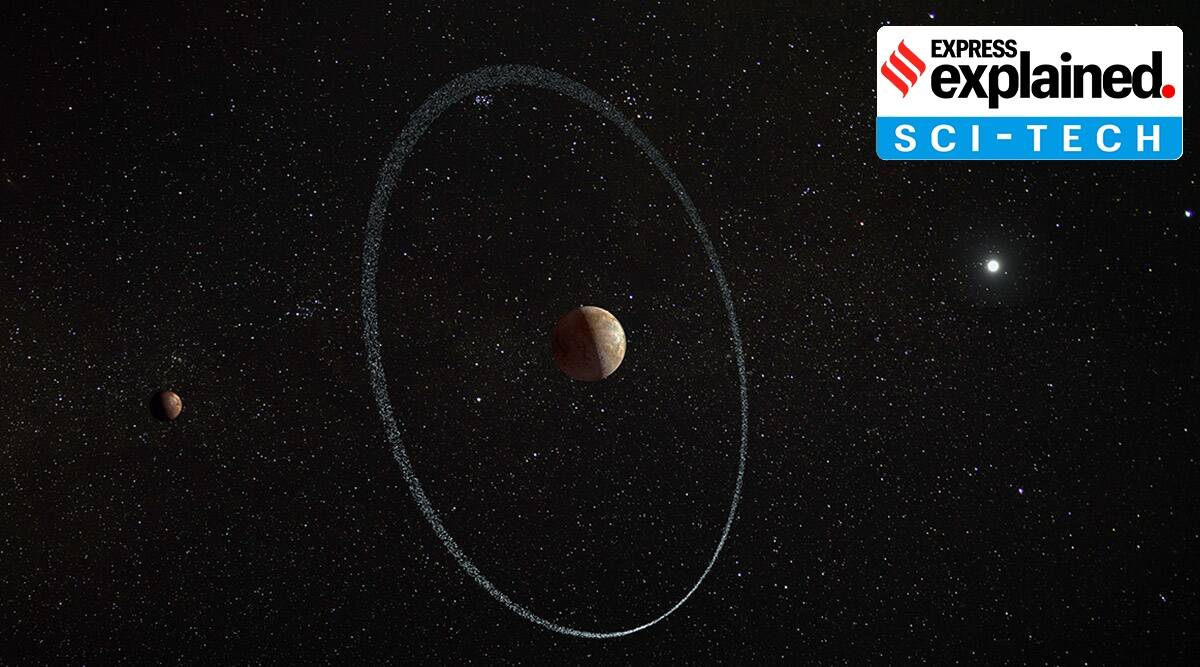- Located at a distance of 2,500 miles from the dwarf planet, the ring is so far from the Roche limit that it should have coalesced into a moon.
- The most powerful telescopes have revealed Quaoar as only an indistinct blob, which also has a moon, Weywot.
- Astronomers have found a ring around a dwarf planet, located in the Kuiper Belt at the solar system’s edge, called Quaoar, according to a new study.
- The ring, however, is positioned much further away from the planet than is usual and defies theoretical explanations.
- Published in the journal Nature, the study, ‘A dense ring of the trans-Neptunian object Quaoar outside its Roche limit’, has been done by Bruno Morgado of the Federal University of Rio de Janeiro (Brazil), Bruno Sicardy of the Paris Observatory, and others.
- According to the study, the ring lies far away from the Roche limit — a mathematically determined distance beyond which rings aren’t supposed to exist.
- With an estimated radius of 555 km, Quaoar is roughly half the size of Pluto and orbits beyond Neptune. It also has a moon of its own, which is known as Weywot.
- As the dwarf planet is too small and too distant to be observed directly, the researchers detected the ring with the help of a phenomenon called stellar occultation.
Ring Discovery
- A stellar occultation occurs when, as seen from Earth, a bright star passes behind a planet.
- This allows astronomers or anybody on Earth to observe the sharp silhouette of the planet for a brief period of time.
- The phenomenon, which rarely occurs, is used by researchers to analyse a planet’s atmosphere and determine if it has a ring around it — in 1977, scientists discovered the Uranian ring system with the help of stellar occultation.
- The team involved in the latest study examined Quaoar for around three years, between 2018 and 2021, through Earth-based and space-based telescopes.
- During these years, the dwarf planet passed in front of four stars, helping researchers observe the shadow of the eclipses.
- “However, they also observed some dimming of the starlight before and after the star blinked out. That pointed to a ring obscuring part of the light.

Roche limit
- The most intriguing part of the findings is the distance between Quaoar and its ring.
- Located 2,500 miles away from the dwarf planet, the ring is around 1,400 miles further away from the Roche limit, as per the calculations of the scientists.
- They suggest that at such a distance, the particles of the ring should have come together to form a moon.
- For a further understanding of the Roche limit, let’s look at the Earth and the moon. The Earth’s gravity pulls on the moon.
- However, one side of the moon is closer to the planet and hence, the pull is stronger on the side facing the Earth.
- The result is the so-called tidal force, which either stretches or compresses the moon from all sides.
- What helps the moon keep it together is its own gravity.
- It essentially counteracts the effect of the tidal force.
- But if you bring the moon closer to the Earth, the tidal force will overcome the satellite’s gravity and then disintegrate it, turning the moon into a ring.
- The minimum distance at which this happens is known as the Roche limit.
- It is named after the French astronomer Édouard Roche, who discovered the limit in 1848.
- The Roche limit doesn’t just exist between just the Earth and the moon.
- It is applicable to any planet and the celestial bodies around it.
- For instance, Saturn. The beautiful rings that you see around the planet are within the Roche limit and therefore, there are no moons in that area.
- In 1992, comet Shoemaker–Levy 9 got too close to Jupiter, breaching the Roche limit, and was broken apart by the tidal force.
- Two years later, parts of it collided with the planet, providing the first direct observation of an extraterrestrial collision of solar system objects.
The reason behind Quaoar’s far-out ring
- As of now, nobody exactly knows how Quaoar’s ring has managed to remain stable at such a distance from the Roche limit.
- The researchers of the study have said that there can be a variety of possible explanations but they aren’t sure about any one of them.
- It might be possible that Quaoar’s moon, Weywot, or some other unseen moon contributes gravity that somehow holds the ring stable.
- Another potential explanation can be that the particles of the ring are colliding with each other in such a way that they are avoiding to coalesce into a moon.
- No matter what the reason, astronomers believe the new study points to the possibility of discovering more rings around smaller planets like Quaoar in the outer solar system, which might expand our understanding of planetary ring systems.
 Chinmaya IAS Academy – Current Affairs Chinmaya IAS Academy – Current Affairs
Chinmaya IAS Academy – Current Affairs Chinmaya IAS Academy – Current Affairs



